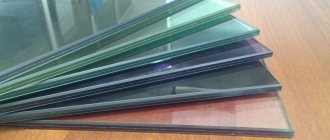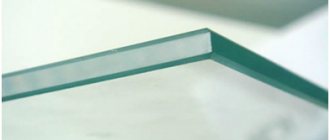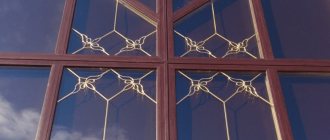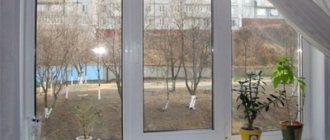Eraglass products are always made from high quality materials. One of them is tempered glass - it is also “stalinite” (from the word “steel” - this name can be found in Soviet articles and books, as well as in the speech of old specialists who began their careers under the USSR). Another name found in common parlance is “kalyonka”. What is this material?
In essence, it is ordinary sheet glass (albeit high-quality cast and rolled: Eraglass specialists monitor the condition of the source materials). The whole secret is what they do with it afterwards. Elements of the required shape are cut out of strips of glass with a thickness of at least 6 mm, and then placed in an oven, where they are heated to a temperature of 650-680°C. Then the hot workpiece is blown with air for rapid cooling. As a result of temperature changes, mechanical stresses increase sharply, which remain after cooling. The resulting material, called “tempered glass,” has a number of interesting properties that make it a unique building material.
Technical features of tempered glass
Having undergone hardening, glass elements produced by Eraglass have the following qualities:
- High mechanical strength. It was not for nothing that tempered glass was called “Stalinite” in Soviet times - its hardness and impact resistance are very close to some grades of steel. According to DSTU B V.2.7-110-2001, building glass of this type must withstand without damage the impact of a steel ball with a diameter of 38 mm freely falling from a height of at least 3 m.
- Thermal strength. Glass elements can withstand temperature differences of at least 120°C.
- Safety. This is the main reason why “template” is used for large glass structures. If the mechanical or temperature damage is too strong, the part crumbles into small pieces of irregular shape that do not have sharp edges. The structural element will be destroyed, but the fragments will not harm people. It will be very easy to restore a step, a display case or a cabin - but living people are irreplaceable. And it is the preservation of their life and health that is ensured by tempered glass from Eraglass.
Weight of tempered glass of different thicknesses
The mass (m) of glass products is calculated using a simple formula: on a calculator, the area (S) is multiplied by a factor of 2.5 and the thickness of tempered glass (h) in millimeters.
m = S * 2.5 * h
| Thickness, mm | Weight m2, kg |
| 4 | 10 |
| 5 | 12.5 |
| 6 | 15 |
| 8 | 20 |
| 10 | 25 |
| 12 | 30 |
The table shows that the greater the thickness of the product, the greater its weight. For this reason, you should be careful when working with thick material: choose fasteners that are suitable for the load and weight, think through the transportation of large products, and protect the ends from impacts.
How it is made
In production, knee glass can be made in two main ways:
- Thermal hardening.
- Chemical hardening.
For a number of reasons, Eraglass prefers to use thermally tempered glass. However, if the customer prefers, he will be provided with tempered glass made by chemical means. In any case, it will receive unbreakable glass that can withstand high loads and temperature changes without harm to users.
Modern production of tempered glass
The best tempered glass is produced using equipment that allows, at all stages of the process, extremely precise control of the main parameters that determine the quality of the final product. For these purposes, special CNC lines are used. Managing the production process using software allows you to select the necessary parameters for each type of glass as accurately as possible, because today the following are subject to tempering:
- glass thickness from 4 to 19 mm;
- sheets format up to 4400x2440 mm;
- bent products.
To ensure high quality, each type requires the creation of individual hardening conditions. Glass that has undergone this treatment is classified according to European (EN 12150-2) or American (ASTM) standards.
What is thermal tempering of glass
Thermal hardening is a method of processing glass parts in which:
- First, the workpiece is formed. The calon is not processed, so the part is cut out of the sheet, if necessary, bent, holes are drilled in it and chamfers are made along the edges (in this case, the rounding of the edge of the hole must be no less than its radius).
- Then the workpiece is heated. The temperature depends on the brand of glass and its thickness.
- After heating, the part is quickly cooled by blowing cold air. The blowing algorithm complies with the technical conditions, and it is different for each part. Therefore, hardening is carried out in computer-controlled furnaces.
- The finished part is tested and handed over to the customer.
Tempering stele
Tempering glass is similar to the process of tempering steel. The glass is first heated to the softening stage, and then sharply cooled. Cooling of the inner layers of tempered glass causes residual compressive stresses, providing mechanical and thermal stability.
- It is necessary to check the glass for cracks and other defects. If any are found, then hardening should be abandoned.
- Before tempering, glass is given the required shape (bent, cut, etc.). After tempering, the glass will be much more difficult to cut; you will have to perform the reverse procedure to the tempering process.
- Sand sharp edges with an abrasive tool.
- Clean and wash all surfaces of the glass product. Dirt, grease stains, etc. can have a significant impact on the hardening process.
- Place the glass (piece) in the kiln and heat to 600 degrees Celsius (1112 Fahrenheit). In industrial conditions, hardening is carried out at a temperature of (650–680 °C) degrees Celsius.
- At the next stage, the heated glass is blown with strong air currents from different angles. As a result, the outer and inner layers of glass cool at different rates and acquire different structures.
Where is it used?
Tempered glass is used:
- For glass walls and partitions in the interior. Upon request, we can produce both interior partitions and full-fledged walls that can withstand heat, cold and impacts from the outside.
- For fences and fences. If you need to enclose part of a space, glass walls are a good choice.
- For doors. Their strength will protect against any intruder, but at the same time they do not obscure the interior.
- For interior details. Custom-made shower enclosures will fit perfectly into your bathroom design.
- Canopies and awnings. They do not interfere with lighting, but protect against debris, pollution and harmful influences from the outside.
This is only a small part of what the company can offer its clients. In fact, any building part can be made of glass at the request of the customer accurately and on time.
Content
- 1. Differences between triplex and tempered glass
- 2. How triplex and tempered glass are made. Key features of materials 2.1. Strained glass
- 2.2. Triplex
- 3.1. Durability and safety
Accelerated aging test
Although modern glass factories use float technology (controlled cooling on a bed of molten tin) to produce the highest quality glass, the raw materials may contain unnecessary substances. These include, first of all, nickel sulfide: even a small fraction of its molecules in the composition of the part leads to uneven expansion when heated, which damages the crystal structure. As a result, tempered glass can sometimes spontaneously crumble.
To avoid this, the blanks are tested. To do this, they are placed for two hours in a test oven heated to a relatively low temperature (about 300°C). During this time, all parts that contain an excessive amount of nickel sulfide will manifest themselves and crack. Only those that pass the test will be used in construction.
Flaws.
Price. The price of tempered glass for similar sizes is higher than the cost of standard glass. Therefore, with a limited budget for glazing a room with plastic, aluminum, or modern wooden Euro-windows, installing tempered glass in these structures will not be justified.
Impossibility of further development. This is rather a minus for the factory, where this type of glass is adjusted to the required size. Tempered glass cannot be further processed (cut, cut additional holes, etc.), since the structure of the tempered glass itself does not allow this.
Chemical strengthening of glass
In addition to thermal tempering, chemical tempering is also used for glass. In this case, the part is placed in a container heated to 450°C containing potassium nitrate (potassium nitrate). As a result of ion exchange between sodium (which is part of the glass) and potassium in the melt, the surface layers of the part also experience stress, and the glass increases its strength.
The advantages of chemical hardening are:
- Ability to harden parts of any size and thickness. In particular, thin sheets, as well as curved ones, can be subjected to this treatment.
- Glass can still be processed - cut, chamfered, drilled.
- When destroyed, the part is not covered with a continuous network of cracks. That is why plates for triplex, from which car windshields are made, are tempered not thermally, but chemically: even a broken windshield remains transparent enough for the driver to see the road and be able to bring the car to a repair shop.
However, there are also serious disadvantages:
- Chemical hardening is a very environmentally “dirty” method.
- The chemical treatment procedure takes longer than heat hardening.
- Chemically tempered glass still breaks into large pieces with sharp cutting edges. Therefore, in windshields it is used only in triplex: transparent adhesive plastic holds debris, preventing it from flying into the faces of people inside the car.
Vulnerabilities of tempered glass
The most vulnerable part of tempered glass is the side edges and corners. Therefore, dropping a smartphone on any angle or side in most cases ends in cracks or chips. But when falling flat, glass often does not break, provided there are small stones and other protruding objects.
Chip on tempered glass.
The best way to maintain the integrity of tempered glass is to use a cover or bumper that is reinforced with rubber or other materials on the edges. It is also important that the sides of the case protrude 1-1.5 mm above the glass. In this case, if you fall on a flat surface, the impact will be taken by the bumper, not the glass.
FAQ on tempered glass
How to distinguish tempered glass from regular glass?
The easiest way is to break it. The usual one will fall apart into long sharp fragments, the hardened one will fall into glass “grains” of a round shape without cutting edges. But if you can’t hit, there are other ways:
- Inspection of the plane. At a slight angle, the light reflected from the tempered glass causes a slight rippling effect. The cause of the ripples is precisely the overstressed elements of the glass.
- Inspection through a mirror or against the light. Here you need polarizing glasses (drivers usually use them to avoid being blinded by high beams). If rainbow stains are visible on the surface, the glass is thermally or chemically tempered.
Tempered glass how to cut
If thermal hardening was used, no way. Any load from the end (including from the resulting cut) leads to instant destruction. Tempered glass is not cut - it is used in the size it is.
How to drill through tempered glass
The answer is the same - no way. If thermal hardening was used, the drill will instantly crush the part into many rounded fragments. Formally, chemically tempered glass can be drilled, but manufacturers do not recommend this. It is easier to harden a part of the desired shape than to then adjust it to the location.
The better tempered glass
It:
- Much stronger than usual. Calonka is not used only in optics - interference from rainbow spots interferes with obtaining a high-quality image. In all other cases, tempered glass is much more effective than regular glass.
- It can be made colored or tinted to the full depth. The main thing is to weld the right glass, and any glass can be tempered.
- Safely. If such material cracks and falls apart, it will not cause harm to the user.
What is stronger: tempered glass or triplex?
This issue is controversial and depends on the brand of triplex and tempered glass. Anyway, the difference between them is this:
- If the triplex cracks, the fragments hang on the adhesive base without injuring the user. You can even use the pierced triplex for some time.
- If the shoe breaks, that’s it, the object is no longer there, it has crumbled into a safe “grain”. This is why tempered glass is not used in optics or in vehicle windshields.
In fact, both are equally strong.
The only difference is in the method of application. Share
How the strength of glass increases
Tempering of glass in industrial conditions occurs as follows: ordinary glass is made and heated to a temperature of 500-600 degrees, after which the temperature drops as sharply as possible and the glass becomes much stronger due to the formation of compressive stress in its particles.
In addition to many advantages, such glass has significant disadvantages. Drilling and cutting such material is practically impossible, so it is advisable to shape the glass into the desired shape and drill holes before tempering it. Stalinit is also the name for tempered glass, which can be used not only to create airy interiors and glaze windows, but also on a larger architectural scale. Buildings erected in recent years are becoming more transparent and weightless due to huge translucent structures made of stalinite. The appearance of this material has led to the updating of building codes and regulations, which consider it acceptable to use safety glass for glazing large elements of upper floors, as well as balconies and loggias.
How to distinguish tempered glass from ordinary glass
If your production is related to glass processing, there is often a need to select the optimal technology for changing its configuration, for example, cutting with a diamond blade. In such cases, it is important to know for sure that you are dealing with tempered glass. A mistake can result in serious financial costs.
Unscrupulous suppliers often take advantage of the fact that there are practically no external differences between tempered and ordinary glass. However, there are ways to find differences.
- A different sound produced by lightly tapping the glass surface. The sound that tempered glass makes is duller and lower than the sound from ordinary glass.
- Using polarized lenses. With their help you can see mesh contours on tempered glass.
- The most effective way to help avoid production problems and financial costs is to use special point-based instruments to determine the grade of glass.
Material capabilities and applications
The production of tempered glass involves the production of ordinary glass, which is then subjected to very high temperatures (about 550 degrees). After which the temperature is sharply lowered, as a result, compressive stress is created in the glass. Glass acquires its qualities through this process.
Fittings (fasteners) used in the design of the visor
Stainless steel hinges from SADEV are used to fasten the glass.
The fittings have been tested by the CSTB (Institute for the Study of Buildings and Structures).
The design of an all-glass canopy over the entrance to the parking lot. Apart-hotel building st. Ho Chi Minh 14 (St. Petersburg)
Construction of a canopy over a parking lot. Object: Morskoy prospect, 28 (St. Petersburg)
Canopy structure over the entrance to the parking lot. Object: Morskoy Ave. 28 (St. Petersburg Krestovsky Island)
Canopy structure over the parking lot exit. Elite residential complex "AYNO" KIM Ave., no. 1, lit. A(St. Petersburg V. Ostrov)
Products
- Glass doors
- Glass visors
- Shower cabins
- Glass partitions
- Glass stairs
- Glass elevators
- Glass floors
- Metal railings
- Metal constructions
- Automatic doors
- Glass facades
- Glass wall cladding
Tempered glass processing and cutting
Tempered glass has an unusual structure obtained during its manufacturing process.
The specificity of the structure requires a special approach to all methods of its processing, including cutting. It is recommended to change the configuration of future products, drill them and other work before hardening is carried out. However, there are times when it is necessary to change the configuration of a pre-hardened product. If you use a special processing machine with the ability to set a cutting program, the procedure will proceed without failures or surprises. The difficulty lies in the fact that such machines are quite expensive equipment and are used only in production.
Processing and cutting this material manually is a very complex and time-consuming procedure. It is carried out using a simple diamond glass cutter, however, there is a limit on the maximum thickness of the product. It should not exceed 5 mm. To reduce the level of tension on the glass surface, it must be pre-treated with White Spirit. After this, an incision is made, forming a future surface fracture.
Features of material production
Tempered glass is produced by processing a standard material. That is, at the manufacturing stage, no techniques are used that allow the glass to obtain certain mechanical properties or additional durability. Additional elements can be introduced into the composition that will enhance hardening, but they will reveal their potential only after heat treatment. So the production of tempered glass is not possible without firing it and then cooling it. The material is placed in a special oven in which it is heated to a temperature of 650-680 degrees Celsius.
The glass spends a certain period of time in this mode, which depends on the thickness of the material and the chemical composition of a certain brand. After heating, the glass is sharply cooled using an air flow. In this case, air is supplied from both sides, otherwise it will not be possible to temper the glass. As a result of the manipulations performed, a layer with residual compressive stress is formed on the surface of the material, which, upon impact, does not allow the glass to break into fragments, but simply crumbles into square particles.











